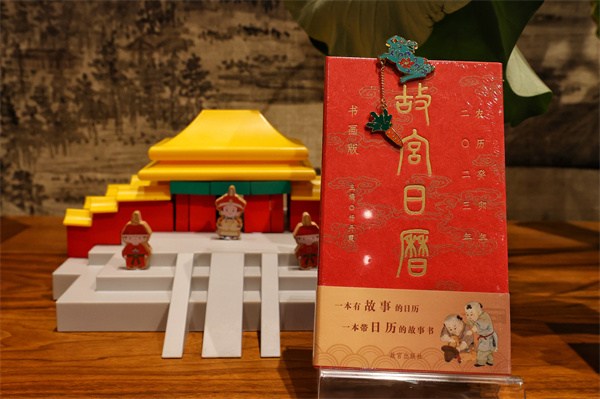
. > WHAT'S NEW > BOOKS
Time for Palace Museum calendar
Author : Wang Kaihao Source : China Daily 2022-08-23

A copy of the 2023 Palace Museum Calendar featuring traditional Chinese figure paintings, displayed in a bookstore at the museum.[Photo provided by Jiang Dong/China Daily]
The hot weather of summer still lingers, but, as usual, the Palace Museum in Beijing is ahead of time as it reminds us, through its calendar, that a new year is not far away.
The museum, also known as the Forbidden City, was the former imperial palace. Every year, numerous fans of traditional Chinese culture avidly follow the release of the new Palace Museum Calendar, which is imminent. More than 4 million copies have been sold in the past decade. Having 1.86 million cultural relics in its collection, the museum has particularly abundant resources to share through these timely, literally, pages.
During a lecture at its bookstore on Sunday, the museum's publishing house announced that the 2023 Palace Museum Calendar will soon be released, but this time, there will be something different.
According to Yang Danxia, a researcher with the Palace Museum and editor-in-chief of the calendar, 365 figure paintings have been chosen for its pages to make it a brief art history book of figure paintings.
Basic information, brief analysis of artistic styles, as well as related stories surrounding each painting will be presented to readers as they start each day by turning a new page.
"We choose one theme for each season," Yang said at the Sunday lecture. "The ethos of figures in the paintings may respectively echo the four seasons.
"It's a calendar full of stories," she says. "Its size is small, but the cultural richness it represents is grand. Readers can thus admire the beauty of Chinese paintings and traditional culture."
For example, court ladies and celebrity women feature in the section of spring and portray, in keeping with the season, a fresh and bright tone. People may want to stay in a cool forest amid hot weather, and their feelings probably resonate with those of figures in the summer section-hermits who retreated from worldly confusion to pursue inner tranquillity.
For autumn, the harvest season, paintings vividly reflect ancient people's daily life revealing vitality, while the winter section creates a solemn atmosphere through portraits of emperors, politicians, generals and other famous historical figures.
The calendar design exquisitely reflects Chinese aesthetics as different aromas are used in printing the paintings: rose flavor for spring, jasmine for summer, apple for autumn to mean "harvest", and, finally, sandalwood for winter.
"But when you view the portraits and better know the figures' stories, you may find various 'flavors' from one character," says Ma Shunping, another Palace Museum researcher and co-author of the book.
From 1933 to 1937, the Palace Museum published its calendars until it was halted by war. The tradition was resumed in 2009. Its popularity made the publishing of calendars a favorite routine for the museum. In the past 12 years, the 12 animals of the Chinese zodiac were chosen as themes for the publishing. Each year's edition mainly featured one animal in that zodiac, introducing cultural relics related to that animal on its pages.
Du Haijiang, deputy director of the Palace Museum, explains that the new calendar featuring figure paintings is thus a creative format to bring the rarely seen relics to more people. To protect paperwork relics, once a painting is exhibited at the Palace Museum, it has to "sleep" in the warehouse for at least three years.
Among the paintings presented in the calendar, there are many household titles like a Song Dynasty (960-1279) facsimile of Goddess of Luo River, one of the best recognized Chinese figure paintings in history. There are also works by monumental artists, including Tang Yin and Qiu Ying from the Ming Dynasty (1368-1644), Song Dynasty emperor and painter Zhao Ji, and Li Gonglin, also from Song period.
New technologies are also used in a tacit way. Augmented reality is deployed for the calendar, enabling readers to view some animated paintings by scanning QR codes. Elaborate audio guides to the paintings, narrated by four researchers from the museum who wrote the book, are also hidden in those QR codes.
The Sunday lecture at the Palace Museum, which was also livestreamed online, is also the beginning of a 10-installment series promoting traditional culture about the Forbidden City.
Ye Shengtao made Chinese fairy tales from a wilderness
Ye Shengtao (1894–1988) created the first collection of fairy tales in the history of Chinese children’s literature...
-
How northern ethnicities integrated into Chinese nation
2023-09-18
-
Mogao caves
2023-09-12
-
Mogao Grottoes as ‘a place of pilgrimage’
2023-09-12
-
Time-honored architectural traditions in China
2023-08-29
-
Disentangling the civilizational evolution of China
2023-08-28
-
AI ethics in science fiction
2023-08-23













 2011-2013 by www.cssn.cn. All Rights Reserved
2011-2013 by www.cssn.cn. All Rights Reserved